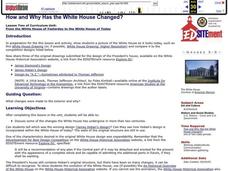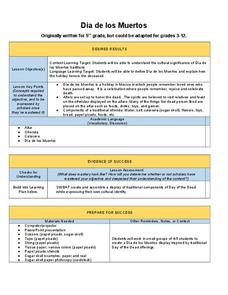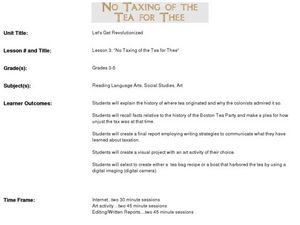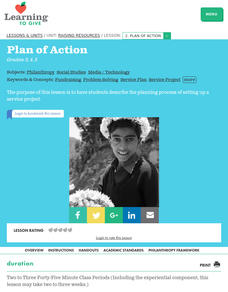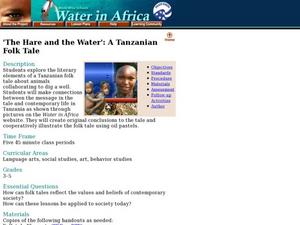Curated OER
How and Why Has the White House Changed?
Students examine changes the White House has undergone in the past two centuries. They view and discuss online images and designs, compare diagrams, read information from various websites, and answer discussion questions.
Curated OER
Native Americans of Our Region
Students describe the life of a Native American tribe native to their area. They form small groups and visit stations in the classroom to read about various Native American tribes. They write journal entries and draw pictures of the...
Vanderbilt University
Dia de Los Muertos
To honor El Dia de los Muertos, scholars work together to create Day of the Dead displays—paper sugar skulls and banners—that bring a festive and memorable flare to the classroom.
Curated OER
What's In A Name? British Surnames Derived from Occupations or Professions
Students examine British surnames that are derived from family occupations. They investigate some of the more common names that are still prevalent today.
Curated OER
What's In A Name? Non-British Surnames
Students investigate the origins of Non-British surnames that exist in modern America. They examine the meanings of these surnames.
Curated OER
No Taxing of the Tea for Thee
Research the history of the Boston Tea Party. Learners read the book The Boston Tea Party and write down important facts. They use the Internet to continue their research and construct an art project of a boat that contains a tea bag.
American Psychological Association
Teaching Is Fundamental
It's important for teachers to have a strong support system—especially in the first few years of their career. Help teachers' partners, spouses, and friends understand the most compassionate ways to provide emotional support with a...
Curated OER
Learning Through the Duke
Learners examine the contributions of Duke Ellington to the field of jazz. They create an original poem using popular vocabulary from the 1920s, listen to the book, "Duke Ellington," and paint a picture while listening to music by Duke...
Curated OER
Traces: Historic Archaeology
Students list at least five different kinds of artifacts archaeologists have found in U.S. excavations. They cite artifacts when describing life at a particular archaeological site.
Curated OER
Global Trek
Students investigate people, places and environments. Using the internet, students gather information about the country and culture that they visit. Students use Classport technology to collaborate and communicate with students on a...
Curated OER
From the White House of Yesterday to the White House of Today: A President's Home and the President's House
Stduents look closely at what one President did at his home in contrast to what Presidents have done in the White House. They take a virtual tour of the White House and Monticello.
Curated OER
Cultural and Historical Meaning: Little Johnny Brown
Learners perform a folk dance and discuss its cultural and historical meanings. They review the dance and perform it, beginning with four individuals who dance with confidence right from the start.
Curated OER
The Gettysburg Address
Students become familiar with the Gettysburg Address as well as the historical importance of the document in history. They brainstorm its implications and then in groups translate the language used in the address into modern day...
Curated OER
Discovering Your Heritage
Students interview a family member about their heritage. They listen to and record part of their family's oral history. Students also create and label a family tree going back a minimum of two generations and compare and contrast...
Curated OER
Make an "I'm Thankful For..." Placemat
Learners compare and contrast what they are thankful for and what the pilgrims were thankful for, and create a Thanksgiving placemat. They read and recite the poem "I'm Thankful For," and create a laminated landscape placemat that...
Curated OER
Technology Integration
Third graders describe and locate the five geographical regions of the state of Virginia. Using that information, they organize the descriptions in a database they created. They are graded based on accuracy and spelling all noted on a...
Curated OER
Anno's Mysterious Multiplying Jar
Upper graders write word problems and research the uses of multiplication. They start off by taking a pre-test on multiplication and then read the book, Anno's Mysterious Multiplying Jar. They make up word problems to go with their...
Curated OER
Geography and our Family Favorites
Young scholars talk with older family members about favorite family foods and where they have originated. They learn the process that went into the preparation and cooking of these foods and contrast how technology has affected food...
Curated OER
Working Animals
Learners discuss the role of animals and how they can work with people to better the community. In this working animals lesson plan, students discuss how animals and people work together to complete different tasks in the community.
Curated OER
Plan of Action
Students examine the process of setting up a service project. They describe this plan to help a family in need in their community. They evaluate the project after its completion.
Curated OER
Jobs and Places
Students match a job to where this job would be performed. In this jobs and places lesson plan, students have to decide where a certain job would be performed by filling out a worksheet and drawing a symbol to match each place.
Curated OER
Symbols of Our State: Arkansas
Here are a series of lessons designed to assist early elementary learners to discover the symbols of Arkansas. They learn about the state flag, insect, state seal, state bird, flower, tree, and gem. A booklet (emedded in the plan), is...
Curated OER
The Hare and the Water: A Tanzanian Folk Tale
"The Hare and the Water," a Tanzanian folk tale, lends a global perspective to literary analysis. Learners spend the first two days reading and storyboarding. On day three, they examine folk tale elements (worksheet included), and design...
Curated OER
My Arkansas Family Tree
Here is a two-part lesson that introduces learners to genealogy by having them create family trees, and map the movements of their ancestors. While this resource is designed for kids who live in Arkansas, it certainly can be adapted for...
